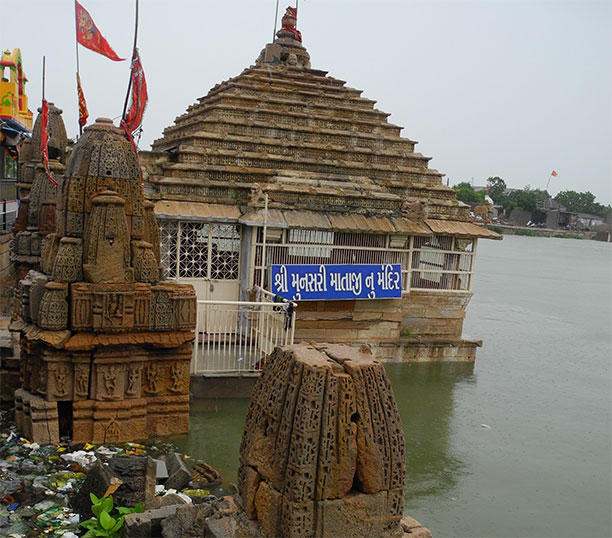Voices: Rain, Ruin, and Resilience
Exploring the cultural heritage site of Munsar Talav in India
July 22, 2017. Rain pounded my back and drenched my kameez just as I stepped out of a car. I was in Viramgam, a village on the outskirts of Ahmedabad city in Gujarat state in western India. Before me stretched a vast man-made lake, the size of two football fields, excavated perhaps 1,000 years ago. Around its perimeter stood several hundred sandstone temples replete with figural carvings of the Hindu pantheon and curvilinear superstructures. This was Munsar Talav. Munsar, redolent of Lake Manasarovar in the Tibetan Plateau, which has long held a special place in the imagination of millions of Hindus, Jains, and Buddhists. Munsar, which ought to be regarded as a jewel of India’s cultural heritage, was choking with raw sewage, domestic and industrial effluents, and reeking garbage. As buffaloes huddled close to its edge, village boys exuberantly plunged into the lake’s churning waters, innocently lathering their bodies in toxic pollutants.
As I took in my surroundings, I saw my husband waving enthusiastically, unfazed by the downpour. He is a professor of South Asian art history at the University of Michigan. We were at Viramgam with graduate students from Michigan and Penn. Our aim was to begin documenting Munsar Talav through photographs, site maps, and measured ground plans. Through our endeavor we aimed to begin studying the medieval temples and ultimately launch a public-facing humanities project to conserve Munsar Talav.
The rain hindered us at every step. Notebooks turned into pulp and ink turned into dark jets. The foundations of temples were submerged and precluded our entry into them. As we walked around the perimeter, we saw centuries-old temples quavering like a flotilla in a tempestuous sea. Tufts of grass sprouted from their towers. Putrid water backing up into Munsar Talav from sewage plants lapped against their richly carved walls gnawing sculptures and loosening stones. Around the unsteady temples lay fragments of hundreds of other temples that had succumbed to the vagrancies of man and nature.
Alongside the annihilation of these monuments, we witnessed religion’s resilience. As we entered a medieval shrine honoring Munsar Mata, the goddess of the lake, a priest recited prayers and drew our attention to a local custom of offering heads molded from clay to the goddess. Was this custom a remnant of sacrifices that the deity once received? Or maybe a promised cure for those seeking relief from a headache?
Looking away from the water, we found ourselves staring at other crises. Government lands had been encroached by shanties, graveyards, temples, mosques, and other unplanned development. Pollutants from homes and local businesses alike were being discharged into a network of natural lakes that are connected to Munsar Talav, and storm gutters were choked with non-biodegradable refuse. Bloated corpses of giant monitor lizards floated in the water, and feces were tossed amongst mounds of garbage. Children with skinny legs, protruding ribs, and bloated stomachs played in the rain.
Classical Indian texts tell us that our gods delight in dwelling in towns with pleasure gardens and near ponds blooming with lotuses and resounding with the pleasant calls of aquatic birds. How then has Munsar Talav come to be in such a derelict state and its surroundings in such squalor? What might its future look like? As I began to grapple with these questions, I came to understand that Munsar Talav represents a hive of interconnected problems and prospects of a rapidly transforming India. What has led Ahmedabad, Viramgam’s significantly more prosperous neighbor and a booming metropolis, to gain recognition as India’s first and only UNESCO World Heritage City, while Viramgam’s monumental remains sink into oblivion? And more broadly, how might we as a nation nurture equitable economic development, house and heal an immense population, create accessible public spaces, conserve fragile ecosystems, manage perennial cycles of the scarcity and plentitude of water, and think about the place of the past in the ever-changing present?
In the weeks since our visit to Munsar Talav, we have redoubled our efforts to conserve the site, establishing lines of communication with diverse stakeholders: government officials, archaeologists, conservation architects, hydrologists, public health specialists, corporate leaders, and cultural policymakers. Where these conversations will take us, time will tell.
Jahnabi (Barooah) Chanchani ’11 is a visiting scholar in the Department of Asian Languages and Cultures at the University of Michigan, Ann Arbor. She holds an M.A. in religious studies from Harvard University and is currently researching and writing on manuscript culture and literary production in premodern western India. Readers can contact her at jahnabi@umich.edu.
This essay is part of a series of personal essays at PAW Online. If you would like to contribute, contact us at paw@princeton.edu.












1 Response
Syeda Jebeen S. Shah
8 Years AgoHope and Support
Jahnabi: Thanks a lot for sharing this essay on Munsar Talav, India. Excellent. While I feel terrible to learn about the current situation, I am hopeful that your team from the U.S. will be able to move mountains (read: garbage, filth and pollutants, and what not), and restore this ancient place to its former glory. Just keep working with all the stakeholders that your team has already contacted; do not give up.
All the best with this project.